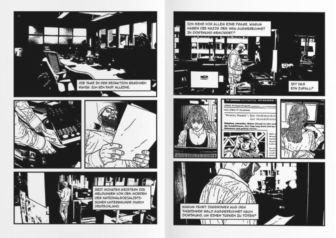There are no rules to journalism as innovative storytelling — just keep it real.
David Schraven who heads the investigative newsroom at Correct!V as publisher, is punting this line, and says innovation in an era of new storytelling means so long as the facts are solid, the telling of these facts can be wide open to experimenting, testing and refining.
Schraven’s newsroom has experimented with everything from mobile journalism to graphic novels and theatre in how they tell their stories.
“When people read a graphic novel they tend to remember it and to talk about it for a long time,” he says.
Correct!V has seen impact in different audience responses and engagement and even resolution or awareness for their concerns, in some cases. It can be empowering for people who have lost trust in conventional media and in governments, he says.
Schraven was part of this morning’s #GIJC17 session on “Innovations in Storytelling.” He and fellow panelist Juliana Ruhfus, a reporter and producer specializing in filmmaking and investigative work, and Susanne Reber, executive editor of Reveal are pioneers in pushing the boundaries for innovative journalism storytelling. And in these unchartered waters their advice is about pushing and expecting to fail, then getting up and trying again.
It’s also about responding to audience’s demand for more immersive, personalized experiences in how they consume any kind of media.
Ruhfus has been behind groundbreaking projects that use gaming formats in virtual environments and audience interaction to tell investigative stories, such as the interactive news game Syhacked about the Syrian cyberwar and her film Pirate Fishing about pirate fishing in Sierra Leone.
“We did a lot of testing and we kept rebuilding,” she says of taking the time to work on something that involves re-teaching audiences and even journalists and editors about a world that merges journalism with a diverse range of different skills in getting to a final product.
She also says they ensured that the news element was constantly foregrounded throughout the creation of their “game” to ensure that the checklist for truth and quality reporting were intact.
Ruhfus adds that it’s in this new process for making stories it’s essential to learn from each other and to find the right expertise for the job.
For Reber, leading newsrooms closer to the point where they’re prepared to take the plunge into innovative storytelling, means constant pushing and re-strategizing. “Innovation is something that must be baked into every newsroom conversation and we need to keep asking who we are communicating with and how we are reaching that audience,” she says.
Moderator Reg Chua, data and innovation editor at Thomson Reuters, says thinking through new ways of storytelling in the newsroom enlarges the scope of thinking about journalism ethics and judgment which, in this new terrain, applies to everybody from a developer to an illustrator and even a stage manager and producer.
It’s a brave new world for journalism and the best thing is its open to anyone to reshape. As Schraven puts it: “Classical journalism is like a tune playing and new innovation in storytelling, by adding an illustrator, developer or a stage producer, is like hearing the full orchestra playing.”
Top Tips
- Find the right experts for the job: it’s about collaboration and learning.
- Keep pushing the conversation: it’s new to everybody.
- Be prepared to fail and to try again.
- Ethical, good journalism and judgement applies; the rest is play and experimentation.
 Ufrieda Ho is an independent journalist based in Johannesburg. She is author of Paper Sons and Daughters.
Ufrieda Ho is an independent journalist based in Johannesburg. She is author of Paper Sons and Daughters.


